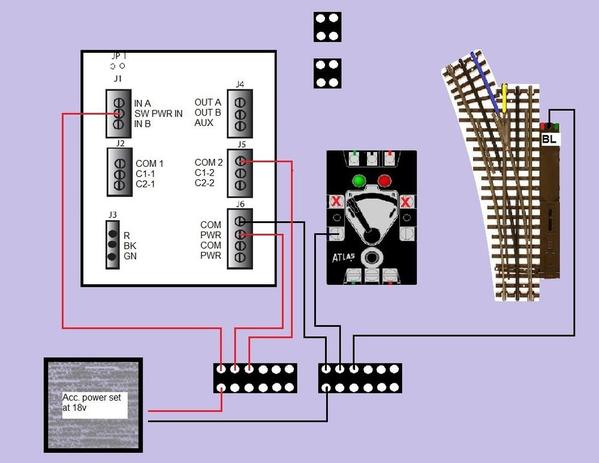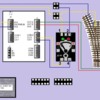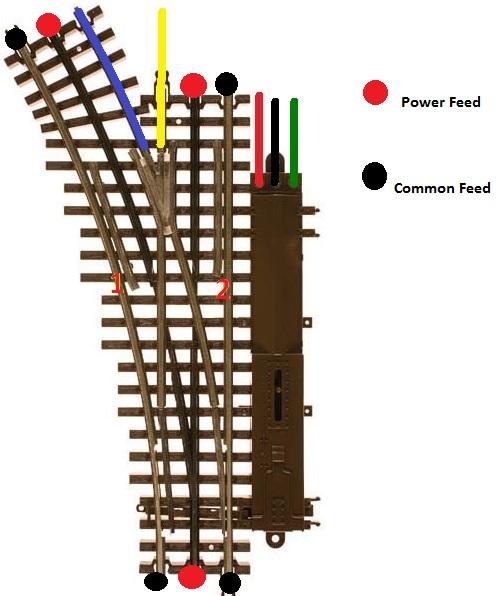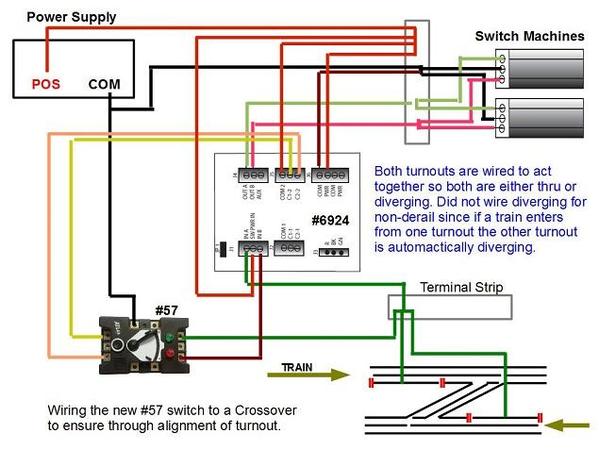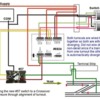Hey Gang,
I'm editing the post to make this tutorial a little more user friendly. This tutorial will assist in wiring the Atlas 6924 non-derail board with the Atlas #57 switch control. It will not cover powering the closure rails. I'll be breaking down the wiring into two parts covering power and common, and isolated rail detection and switch machine control. I'll also include a testing and troubleshooting section at the end should you encounter any problems as I did.
The wiring will follow Atlas' schematic with the following exceptions: the color of the wires will be different and all power will come from the accessory side of the transformer.
Materials Used
- Atlas 6924 Non-Derail Board
- Atlas #57 Switch Control Box
- Atlas #312 5 Conductor Ribbon Wire
- Barrier Strips
The 5 conductor ribbon wire is optional, but I found very useful. It provided 5 different colors which made keeping track of each wires function easier and helped reduce any confusion during wiring. The barrier strips are also optional. This was a personal decision of mine as I found it easier to assist in troubleshooting rather than splicing wires together and then having to undo the splice.
Wire Reference
- Power - Red (exception: red wire running from the switch motor to 6924)
- Common - Black
- Isolated Rail Detection and Direction Control -Blue and Yellow
- Switch Motor - Red and Green
- Switch Motor Common - Black
The color scheme was changed to fall in line with my layout wiring in which red is used for power and black is used for common. It made more sense to me that if I were holding a red wire, it was meant to power something. If you already have a layout built and used different color wiring, simply substitute your wiring color scheme.
Wiring Power and Common
In order to operate, the 6924 n/d board requires a power supply of 6v - 22v AC/DC supplied to J6. I chose the accessory side of my transformer for all power inputs into the 6924 to eliminate the need for a second power source.
Power (red) is routed to the following terminals:
- 6924 terminal J1 - SW PWR IN
- 6924 terminal J5 - COM 2
- 6924 terminal J6 - PWR
Common (black) is routed to the following terminals:
- 6924 terminal J6 - COM
- #57 Switch Control terminal labeled C - Take special note and care when wiring to the #57. Connecting to the posts with the red X will damage the 6924 n/d board.
- Switch Machine terminal labeled BL
This tutorial only covers the use of one 6924. The 6924 can be daisy chained to supply power to additional 6924's. To enable this function, install the jumper on JP 1. refer to the Atlas instructions for further wiring.
Isolated Rail Detection and Switch Machine Control
Through Route Detection (Yellow)
The through route isolated rail detection wire and the wire from the #57 switch control terminal labeled 1 will be connected. (In my case, I used a barrier strip.) The connected wires are then run to the 6924 terminal J1 IN A. Next, connect the #57 switch control terminal labeled 3 to the 6924 terminal J5 C1-2.
Diverging Route Detection (Blue)
The diverging route isolated rail detection wire and the wire from the #57 switch control terminal labeled 2 will be connected. The connected wires are run to terminal J1 IN B. Next, connect the #57 terminal labeled 4 to the 6924 terminal J5 C2-2.
Switch Machine Control (Red, Green)
Connect the wire from the switch machine terminal labeled G to the 6924 terminal J4 OUT A. Connect the wire from the switch machine terminal labeled R to the 6924 terminal J4 OUT B.
Testing and Troubleshooting
Before turning on the power supply, ensure the power is set to within the 6v - 24v range. (Since I am using TMCC, my power preference is 18v to keep things logical and in order for my taste. The transformers I will be using allow me to set a custom voltage. Other transformers may have a set output. Just ensure it is within range.)
Turn on the transformer and look for the LED located on the 6924. If it is lit, the 6924 is receiving power. If it is unlit, check for proper voltage and any loose connections.
Set the #57 Switch Control for the through route*. Move the lever to N** and press the activation button. The green indication light should be lit. If the red indication light is lit, reverse the wires to the 6924 terminal J5 C1-2 and C2-2. Cycle the #57 Switch Control by moving the lever to R**, press the activation button, and then move the lever back to N and again press the activation button. Once the green light is synced, check the points of the turnout. The points should be aligned as follows: green indication light with the through route and red indication light with the diverging route. If the points and indication lights are out of sync, reverse the wires to the 6924 terminal J4 OUT A and OUT B.
* The through route is the route the train would normally travel. In most cases, the through route would have the points set to straight and the diverging points would be turned out. In some cases, the modeler uses the points turned out as the through route and the points set as straight for the diverging route.
** For those of you asking what the N and R stand for, I had the same question and did a little investigating. N "Normal" is the main track route and R "Reverse" is the diverging route. If you are looking for more information on CTC control, would like to build your own CTC panel, or want to look at some eye candy, the CTC Parts website is a great read.




